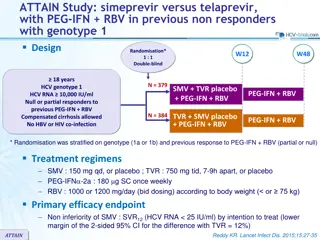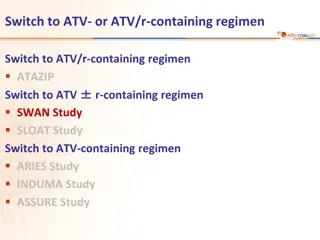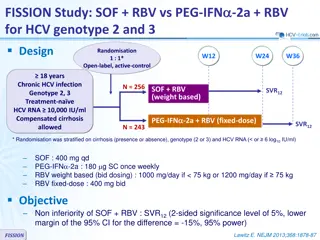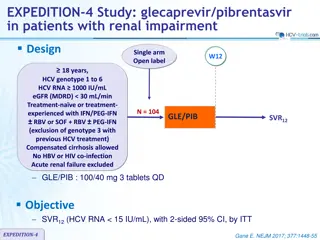Sofosbuvir-Containing Regimens in Renal Disease Patients: HCV-TARGET Trial
Study features a longitudinal cohort examining sofobuvir-based regimens in chronic HCV patients with renal disease, highlighting SVR12 rates, safety concerns, and treatment conclusions.
Download Presentation

Please find below an Image/Link to download the presentation.
The content on the website is provided AS IS for your information and personal use only. It may not be sold, licensed, or shared on other websites without obtaining consent from the author.If you encounter any issues during the download, it is possible that the publisher has removed the file from their server.
You are allowed to download the files provided on this website for personal or commercial use, subject to the condition that they are used lawfully. All files are the property of their respective owners.
The content on the website is provided AS IS for your information and personal use only. It may not be sold, licensed, or shared on other websites without obtaining consent from the author.
E N D
Presentation Transcript
Graphing Polynomial Functions Lesson 3.4 Day 2 Notes
Learning Targets Determine key features of a polynomial graph Use the Leading Coefficient/Degree Test to determine the end behavior of graphs of polynomial functions. Find and use zeros of polynomial functions as sketching aids
Polynomials What do you remember about polynomials? What would be key features of polynomial graphs?
Polynomials Graphs of polynomial functions are continuous. That is, they have no breaks, holes or gaps. Polynomial functions are also smooth with rounded turns. Graphs with points or cusps are not graphs of polynomial functions.
Polynomials Polynomial functions of the form ? ? = ??,? 1 are called power functions.
Given the polynomials below, answer the following.. A. What is the degree? B. What is its leading coefficient? C. How many turns (relative maximums or minimums) could it have (maximum)? D. How many real zeros could it have (maximum)? E. How would you describe the left and right end behavior of the graph of the equation? F. What is its y-intercept?
Zeros of Polynomial Functions A real number ? is a zero of a function ? = ?(?) if and only if ?(?) = 0 Real Zeros of Polynomial Functions If y = f(x) is a polynomial function and k is a real number then the following statements are equivalent. 1. ? is a zero of ?. 2. ? is a solution of the polynomial equation ?(?) = 0 3. ? ? is a factor of the polynomial ?(?). 4. (?,0) is an x-intercepts of the graph of ? = ?(?). A turning point of a graph of a function is a point at which the graph changes from increasing to decreasing or vice versa. A polynomial function of degree ? has at most ? 1 turning points and at most ? zeros.
Zeros of Polynomial Functions Repeated Zeros If ? is the largest integer for which ? ?? is a factor of ?(?) and ? > 1, then ? is a repeated zero of multiplicity ?. 1. If ? is odd the graph of ?(?) crosses the x-axis at (?,0). 2. If ? is even the graph of ?(?) touches, but does not cross through, the x-axis at (?,0).
Example 1: Find all real zeros of ? ? = 2?4+ 2?2 Then determine the number of turning points of the graph of the function.
Example 1: Find all real zeros of ? ? = 2?4+ 2?2 Solution: To find the real zeros of the function, set f(x) equal to zero and solve for x. 2?4+ 2?2= 0 2?2?2 1 = 0 2?2? 1 ? + 1 = 0 So the real zeros are x = 0 (multiplicity 2), x = 1, and x = -1. Set ?(?) equal to 0. Factor out common monomial factor. Factor completely. Set each factor equal to zero and solve for x. Because the function is a fourth degree polynomial, the graph of ? can have at most 4 1 = 3 turns.
Example 2: Find all real zeros and turning points of the graph of ? ? = ?4 ?3 2?2 Then sketch the graph. Factored form is: ? ? = ?2? 2 ? + 1 Based on the factors the zeros are: ? = {0 ???????????? 2 ,2,??? 1} These correspond to x-intercepts at: (0, 0), (2, 0), (-1, 0) End behavior: left side rises, right side rises. Turning point
Descartes Rule of Signs Descartes Rule of Signs says that when the real zeros of a polynomial function are put in order, they divide the real number line into intervals in which the function has no sign changes. These resulting intervals are test intervals in which a representative x- value in the interval is chosen to determine if the value of the polynomial function is positive (the graph lies above the x-axis) or negative (the graph lies below the x-axis).
Example 3: Find all zeros, and turning points of the graph of ? ? = 2?3+ 5?2 ? 6 Then graph. Hint: You will have to factor using Rational Root Test. Possible zeros: 1,2,3,6,1 2,3 2 Now factor the quadratic: 2?2+ 7? + 6 2?2+ 4? + 3? + 6 (2? + 3)(? + 2) Factored form of f(x) is ? ? = (? 1)(2? + 3)(? + 2)
Example 3: Find all zeros, and turning points of the graph of ? ? = 2?3+ 5?2 ? 6 Then graph. Factored form of f(x) is ? ? = (? 1)(2? + 3)(? + 2) Zeros are: x = 1 passes thru, x = -3/2 passes thru, x = -2 passes thru Y-int: ? 0 = 2 03+ 5 02 0 6 (0, -6)
Example 3: Find all zeros, and turning points of the graph of ? ? = 2?3+ 5?2 ? 6 Then graph. End Behavior: odd degree positive leading coefficient = left falls, right rises Max turning points = 3 1 = 2 Graph: Zeros are: x = 1 passes thru, x = -3/2 passes thru, x = -2 passes thru Y-int: (0, -6)
Example 4: Find all zeros, and turning points of the graph of ? ? = ? 1 ? 3 ? + 22 Then graph. Zeros are: x = 1 (passes thru), x = 3 (passes thru), and x = -2 (bounces) Y-int: ? 0 = 0 1 0 3 0 + 22= 12 (0, -12) End behavior: even degree, negative leading coefficient = left falls, right falls Max turning points = 4 1 = 3
Example 5: Find the zeros and graph ? ? = 3?4 7?3 6?2+ 12? + 8 Factor using Rational Root Test. Possible zeros: 1,2,4,8,1 3,2 3,4 3,8 3 Perform Rational Root Test again, using the bottom row (quotient) as top row for next Synthetic Division
Example 5: Find the zeros and graph ? ? = 3?4 7?3 6?2+ 12? + 8
Example 5: Find the zeros and graph ? ? = 3?4 7?3 6?2+ 12? + 8 Now factor 3?2 4? 4 into linear factors 3?2 6? + 2? 4 3? + 2 ? 2 note: (x 2) occurs 2 times and therefore has a multiplicity of 2 Factored form is ? ? = ? + 1 ? 22(3? + 2) Zeros are: x = -1 (passes thru) x = 2 (bounces) x = -2/3 (passes thru) Y-int: f(0) = 8, (0, 8) End behavior: even degree positive leading coefficient = left rises, right rises # of Turns = 4 1 = 3
Homework 3.4 #7, 8, and 36-46 evens























